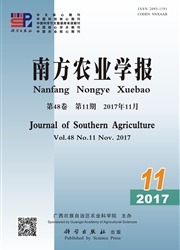

 中文摘要:
中文摘要:
【目的】探索Landsat8_OLI数据对甘蔗种植面积遥感监测的效果,为县域尺度甘蔗产区甘蔗种植面积进行有效追踪和监测提供参考。【方法】以云南省耿马县为例,以Landsat8_OLI为数据源,基于甘蔗的光谱特征,采用非监督分类、监督分类及NDVI剔除法相结合的方法将其他地类剔除,提取甘蔗种植区域。【结果】经精度验证,Landsat8_OLI数据对云南省耿马县甘蔗种植面积遥感监测总体精度为86.36%,Kappa系数为0.7177,生产者精度和用户精度分别为86.83%和90.19%,可满足农业生产的实际需求。【结论】基于Landsat8_OLI数据及光谱和植被指数特征采用非监督分类、监督分类及NDVI剔除法相结合的方法,可准确提取甘蔗种植区域,为综合利用多源数据对甘蔗种植遥感监测奠定基础。
 英文摘要:
英文摘要:
[Objective]The effect of Landsat8_OLI data on remote sensing monitoring of sugarcane planting area was studied,in order to provide reference for effectively tracing and monitoring county-scale sugarcane planting area.[Method]Taking Gengma county,Yunnan province as example and Landsat8_OLI as data source,and based on analysis of spectral signature,the planting areas of sugarcane were extracted accurately by combining supervised and unsupervised classification with NDVI elimination method.[Result]The accuracy verification results showed that,using Landsat8_OLI as data source,the accuracy of remote sensing monitoring of sugarcane planting area in Gengma county was 86.36%,the Kappa coefficient was 0.7177,the producer and user accuracies were 86.83%and 90.19%,respectively.Therefore,this method met practical demands of agricultural production.[Conclusion]Based on Landsat8_OLI data,spectral signature and vegetation index of sugarcane,the planting areas of sugarcane were extracted accurately by combining supervised and unsupervised classification with NDVI elimination method,so as to lay foundation for using multi-source data to monitor sugarcane plantation by remote sensing.
 同期刊论文项目
同期刊论文项目
 同项目期刊论文
同项目期刊论文
 期刊信息
期刊信息
